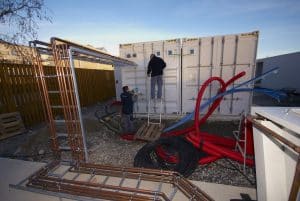NTC Services AS(NTC) has for the past 10 years delivered data center infrastructure as a service/colocation. The feedback from our customers is as follows:
- NTC has so far chosen to build and own the physical infrastructure with SLAs in connection with cooling, electricity, safety, environment and not least quality. So far we have not delivered the servers, routers, switches, storage as part of the service,
but we have assisted customers to get their solutions implemented in our infrastructure. Our colocation can easily take further steps to DCaaS or hybrids of this if it is expedient from a customer perspective. - So far, we have delivered rapid rollout of new hardware in a data center that is ready with racks, A and B power rails supplied from each modular and scalable UPS, A and B fiber patching supplied from meet me rooms, supplied with redundant cooling,
secured with 2 levels of access control, system monitoring and camera monitoring, security services, fire extinguishing and a unit that operates the facility in the event of a power outage. The data center is also shell-proof with a 5-sided internal
module compartment, steel sandwich with a compressed stone wool core. - NTC staffing can assist with all forms of remote hand needs, goods receipt, unpacking, placement, packaging recycling, maintenance of different species – all needs by having an external data center, storage or disaster recovery in a safe and secure
environment. - NTC is confident that we can reduce both Capex and Opex, by offering specialist solutions and services to existing and new customers. Our infrastructure is purchased directly from the largest suppliers in the world, i.e. you have the necessary quality
and the lowest possible purchase price for all installations with associated service now from the best in the industry. - Implementation time can be dramatically reduced from years and months to weeks and days, but of course requires a good rollout plan in advance. We are happy to assist with clarifications regarding all infrastructure challenges that a rollout project
will face. - By using NTC on external infrastructure, the deployment of tasks that expensive IT personnel will not need to spend time on to specialists within the niche data center to provide an enormous flexibility gain in the form of the right resources for
the right tasks. - Another benefit at NTC is that we are not concerned with square meters in relation to loads. We adapt to the customer’s needs, from the typical standard below 10kW per rack and in practice up to what the customer actually needs. We have technology
that supports up to 200kW per rack, if hardware for this type of load is available. - The services from NTC include 24/7 on-call arrangements, so that customers do not need to worry about uptime requirements for electricity and cooling.
- There are many important selection criteria in connection with who you want critical data center solutions and applications with, not just secure uptime. One of the criteria should be the best possible energy saving in the facility, i.e. the best
possible Power Usage efficiency (PUE). This is measurable and easy to obtain. Our facility is currently at 1.2 and with new technology we will continue to decrease. We aim down towards a real PUE of 1.1 as realistic. - Furthermore, we are very concerned about the CO2 footprint. As we have built and will build in existing buildings today and in the future, our facilities have enormous savings in the consumption of steel and cement, 2 materials that have large emissions
during production. - Last, but not least, we extend the life cycle as far as possible in connection with non-critical equipment, which is not a single point of failure. It could be, for example, used racks, which normally have a lifespan of more than 20 years. We have
sold some item numbers of this kind since 2005 and the same product is still on sale today. There may be use of modular and scalable technology on e.g. UPSs, so that at any time you can scale in relation to actual need and at the same time have
the opportunity to replace parts of the installation instead of the entire solution. It is also very sensible in combination with Lithium battery solutions that extend the life cycles up to 15-20 years, instead of half that which was the norm
in the past. It is only a matter of good design and a reuse strategy that provides enormous environmental savings over time.
—